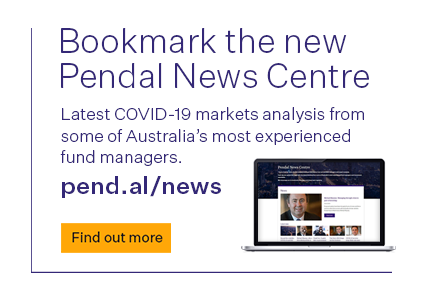Crispin Murray: how to judge who’s best placed for the recovery
Pendal head of equities Crispin Murray presents a COVID-19 market update and shares how he’s assessing which companies will emerge in a strong position after the recovery.
Watch this short video recorded at Crispin’s home office, or read the transcript below.
TRANSCRIPT
Hello everyone , it’s Crispin from Pendal Group with an update on our thoughts on the market.
We’ve been speaking about this being a phase of maximum uncertainty — a combination of lack of clarity on the scale and degree of the health crisis and the uncertainty around the size and the speed of the policy response.
Today I’m going to speak to how we see these issues evolving and I’m going to break it down into four components.
1. Health
First is on the health side. We’ve seen countries like Italy plateauing in terms of new cases but at very high levels and no real signs of these levels letting up. Equally we’ve seen in the US an acceleration of cases as testing has been rolled out.
We’re getting a sense of the true scale of the virus spread and a clear warning of the consequences of not imposing enough restrictions on activity.
In Australia there have been some early positive signs that measures are helping contain the case numbers. Also importantly the severity of case so far have remained relatively low.
Clearly this can change quickly, but it does have important implications both for the health outcomes and also the duration and the depth of the economic downturn required to manage the flow of cases through the health system.
2. Policy
On the policy front we have seen good progress in many countries, notably the US with a government program equivalent to around 10% of GDP.
In Australia we had the government announce their wage support program, which in combination with the already-announced measures, takes the overall response to over 10% of GDP.
These are sizeable programs beyond anything we’ve seen in decades.
They’re critical, not so much for softening the near-term economic blow — that’s going to be difficult because people just can’t engage in economic activity. But they will enable a longer-term pathway to recovery.
Burden business people with too much debt and that will choke any recovery. So this is a necessary investment by the government in human capital.
The wage subsidy is important as it may help contain an even larger uplift in unemployment. Already, we believe this is likely to spike through 10% and potentially up to 15%.
It is also worth highlighting the actions of central banks notably in the US, which are putting in place measures to normalise funding markets. These are critical for businesses to stay solvent and retain labour.
So we should have some greater confidence that the declarations policy makers around the world have made to do whatever it takes is being fired up. This reduces some of the uncertainty and risks in the market.
3. The markets
Greater clarity on policy, combined with the end of the initial liquidation phase,as various funds cut risk and de-gear, has helped stabilise the market in the near term.
The reason we are not yet seeing more meaningful market recovery is due to the growing recognition of the scale of the downturn — in the second quarter with estimates anywhere from down 10% to 30% depending on how long these high level of restrictions remain.
Earnings implications will also be larger. Again, it’s almost impossible to predict right now, but certainly numbers of between 30% and 50% down are possible.
It is important to put some perspective on this because I think we need to think of 2020 as one large collective writedown by corporate Australia.
The focus from an investment point of view is:
– Whether the companies firstly have the capital or the liquidity to ride it out
– Can they avoid being too heavily diluted through capital raisings?
– Whether their businesses will recover relatively quickly or will they be constrained by the potential ongoing limits to activity.
– And finally, are they able to materially reduce their long term costs, for what will be a lower level of activity?
Capital raisings
We should expect a lot of capital raisings.
We’ll need to be selective on these. Focus on the key issues, the type of industry, it’s structure, the company’s market position, quality of the management.
When a company does raise capital, you need to make sure they are telling you the full story.
Are they clearly raising enough money to get them through at least 12 months of weak activity? The market will not be forgiving for companies that have to come back for more capital calls.
Dividends
The other issue I want to flag is the risk to dividends. I think this is material and potentially larger than the market expects.
It may only be the next dividend or perhaps the next couple, but preserving liquidity and capital will be the priorities for a lot of companies and particularly for those industries which are also benefitting from government programs.
4. Companies
Our focus is not to try and make that heroic call on which way the economy and the market goes, but to take a long-term perspective, and build a portfolio that identifies the best companies that meet four objectives.
Either they’re providing protection in a recession; they’re leveraged to policy; they’re good businesses facing short-term challenges but coming through that and being stronger; or they’re companies that will give you protection if we get a very quick solution to this health crisis.
Company example – Amcor
Amcor provides packaging for health, food and personal products. These are all essential items people need where demand is holding up, they are a dominant player in their industry, a lowest-cost supplier and have very good free cashflow.
If things do end up proving to be worse for longer, this is a company that will prove very defensive in the portfolio.
Company example – Nine Entertainment
Yes, Nine is more leveraged to the economic cycle. Yes, it will be impacted by the drop in advertising and the loss of the NRL. But it also benefits from improved subscription to the Stan service. They’ve also been very proactive and announced cost savings of over $200 million.
On top of this, they have a good balance sheet. They are the strongest player in their industry and will be very well placed any recovery.
We expect them to perform particularly well if we see policy is seen to be working.
Final thoughts
We are in an environment where there is still a lot of uncertainty — but also given the drop in the market there is opportunity.
It’s important as investors to stay disciplined. To have a clear plan of actions, stick to fundamental principles and identify those companies where risks are being overly priced into their valuation panel.
Pendal has a team of 17 people in Australian equities. While they may not be able to go out and physically meet with the companies right now, we are engaging in an intense daily program of contact with these companies.
We’ve spoken to well over 100 different companies — some multiple times — to ensure we’re getting as much information, as much insight to enable us to make the right investment decisions and position our portfolios in the best possible way.
With that, I would like to thank you again for your time today.
Crispin Murray
Head of Equities, Pendal Group
This article has been prepared by Pendal Fund Services Limited (PFSL) ABN 13 161 249 332, AFSL No 431426 and the information contained within is current as at March 31, 2020. It is not to be published, or otherwise made available to any person other than the party to whom it is provided.
This article is for general information purposes only, should not be considered as a comprehensive statement on any matter and should not be relied upon as such. It has been prepared without taking into account any recipient’s personal objectives, financial situation or needs. Because of this, recipients should, before acting on this information, consider its appropriateness having regard to their individual objectives, financial situation and needs. This information is not to be regarded as a securities recommendation.
The information in this article may contain material provided by third parties, is given in good faith and has been derived from sources believed to be accurate as at its issue date. While such material is published with necessary permission, and while all reasonable care has been taken to ensure that the information in this article is complete and correct, to the maximum extent permitted by law neither PFSL nor any company in the Pendal group accepts any responsibility or liability for the accuracy or completeness of this information.
Performance figures are calculated in accordance with the Financial Services Council (FSC) standards. Performance data (post-fee) assumes reinvestment of distributions and is calculated using exit prices, net of management costs. Performance data (pre-fee) is calculated by adding back management costs to the post-fee performance. Past performance is not a reliable indicator of future performance.
Any projections contained in this article are predictive and should not be relied upon when making an investment decision or recommendation. While we have used every effort to ensure that the assumptions on which the projections are based are reasonable, the projections may be based on incorrect assumptions or may not take into account known or unknown risks and uncertainties. The actual results may differ materially from these projections.



